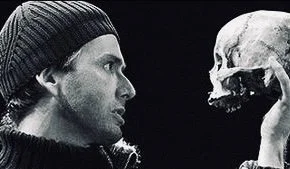From the Top Down: starting with our heads
Published on 4.22.24 at garyborjesson.substack.com
There is nothing either good or bad, but thinking makes it so. - Shakespeare (Hamlet’s words)
I love living in my head. As far back as I can remember it’s been my happy place. Working things out from the top-down has been my default mode. It’s part of why I was drawn to philosophy, and later to meditation, yoga, pranayama, and therapy—all practices that (among other things) leverage our conscious mind for the purpose of enhancing our well being.
In the therapeutic context, top-down approaches focus on the conscious mind. They start with our thoughts and beliefs, with the stories we’re telling ourselves and the scripts we’re living by—to most of which we are, at best, but partial contributors, having “inherited” most of the story from our family and from the culture into which we’ve been thrown. The (safe) assumption of the top-down approach is that what we think and believe have a lot to do with how good or bad we feel—though Hamlet, like other cerebral types (and like some therapies), exaggerates thinking’s part.
Philosophically and therapeutically speaking, top-down work involves distinguishing our own true story, and true self, from our thrownness—which here includes our attachment style and early unconscious adaptation to the world, all of which we adopted before we could consent! From Socrates and the Buddha to Freud, Jung, and Winnicott, great psychologists agree that getting to know ourselves involves separating out what truly is ours from all that we’ve taken in. This includes everything from how we eat and sleep and handle conflict to what we believe about religion and politics and human nature.
So, giving things our conscious attention is a direct and powerful way to change our lives and how we feel about them. As I said, good therapy involves both bottom-up and top-down work. Among the therapies that focus mostly on top-down work are Cognitive Behavioral Therapy (CBT), Acceptance and Commitment Therapy (ACT), Dialectical Behavior Therapy (DBT), and Mindfulness-Based Interventions (MBIs). As you might guess, these tend to be more directive and teachy than are depth or person-centered therapies. This also makes them amenable to being “manualized,” meaning they are turned into manuals that therapists and clients can follow. Not surprisingly, such therapies are also readily emulated by AIs. So, if you’re a CBT or DBT therapist who takes special pride in working strictly by the book, watch your back! There’s a cCBT (computerized-CBT) AI coming for your job. Indeed, many young people are turning to AIs for therapy.
But let’s imagine we’re still talking about a human alliance. Here’s a common situation where top-down work plays a powerful role. A young adult sees a therapist because they are anxious and depressed. The therapist soon learns that beneath these symptoms lie heavy guilt and shame. These in turn are the inheritance from growing up in a fundamentalist religion. The shame is especially heavy because they happen to be gay, which their religion and their family regard as a sin that leads straight to hell. Needless to say, this has made growing up a constant struggle between owning their true self versus identifying with the value system in which they’ve been raised. It’s depressing and anxiety-provoking to think your god, your religious community, and your family will reject you for being who you are.
Just getting all of this out in the open where it can be thought about feelingly is top-down work. The therapist helps the client sort out the specific stories they’re telling themselves about who they are. For example, they have internalized the belief that they have to choose between being a righteous god-fearing person, or being a wayward sinner concerned only with their own pleasure. I once asked a man who was struggling with this: Who says these are your only choices? The question struck him with the force of a revelation because suddenly he saw that he had been unconsciously identified with a dichotomy that now—having been made fully conscious—struck him as laughably false. Of course it wasn’t that simple.
Once our stories are out in the open, “cognitive restructuring” can begin. That’s a fancy way of saying that we can change our minds. For once you notice the typical patterns of self-talk—“I don’t need anybody” or “I always screw up relationships” or “I’m a terrible mother” or “Being gay goes against nature and god”—then you’re in a position to ask yourself if there’s a more accurate and life-enhancing story you can tell.
My patient who had the revelation about the false dichotomy realized he could leave fundamentalism behind and still be a spiritual and moral person. For the first time in his life he saw (as did the youth that Socrates “corrupted”) that what he’d accepted and internalized as the truth were actually beliefs, customs, and conventions that could be (and indeed needed to be!) questioned if he was to find out what he actually believed and make peace with himself. In my patient’s case, over time he changed his script from habitually thinking he was “damned to hell” if he was sexual with someone of the same sex, to thinking “I’m proud I’ve had the courage to live according to my true self.”
The top-down approach is such a powerful and pervasive way of working that it can be easy—too easy—to forget how much it leaves out. And how readily it may be co-opted by forces that don’t have our best interests at heart, by forces that don’t have hearts. More on that very soon.
